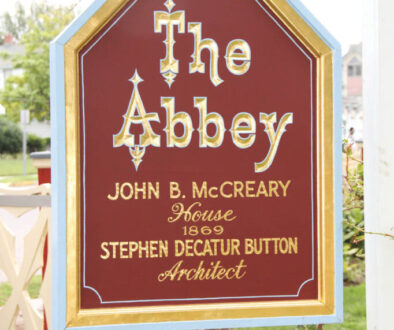The Transformation of 1069: Curves, Curbs, and Curb Appeal

This article is Part 5 of an ongoing series.
If you haven’t read Part 4, click here to do so now!

In 2021, the year after the transformation of the interior of the LaMonica house, the disruptions from the Covid-19 pandemic were giving way to normalcy. Masks and tests were diminishing, but materials and labor remained in short supply.
In early January, Coastline Fence Company came to the property to install a six-foot white vinyl fence with three gates. Weeks before, the lot had been cleared of overgrown foliage and the old stockade and chain-link fences that had surrounded the premises for decades.
Also, by the beginning of the year, the building contractor—still behind schedule—had yet to grade the property or build a driveway and a front walkway. Without them, even a temporary Certificate of Occupancy from the City of Cape May would not be granted. Pressure was building to plan for a move-in date. Something had to be done.
It wasn’t long before this issue became a serious point of contention between Mrs. Stevenson and the general contractor. Too much time had passed and so many dollars had already been spent to get the house right that any more delays would become untenable. She was weary of waiting for the builder to respond to her pleas and to find the right subcontractors to get the work done.


After the old concrete driveway was broken up and hauled away, the builder was nowhere to be found. Everything that was undone was left to Elaine as the homeowner to finish.
Disappointed and annoyed, she knew there were things about her general contractor, now gone from the job, that were essential to the project’s success: his deep experience with all kinds of renovations, his creativity when solving problems, and his willingness to work with a homeowner who was involved in every detail. She knew there had to be some days when he went home and screamed into a paper bag. She admitted she could not have come this far without him, and she missed their collaborations on so many issues. He understood her vision and she knew he got it. But all that was over. She was on her own again to get the house completed enough to move in.
By February she was in touch with a landscaping contractor who had numerous contacts with craftsmen who could finish the exterior work that remained. They agreed that his company would take on the excavation and grading and build the driveway and front walkway. In addition, he would spread topsoil, install sod, and deal with drainage and irrigation. It seemed like the best solution to keep the project moving toward completion. He recommended a stone mason with whom Elaine contracted separately to do the back patio as well as the curbing, sidewalk, and street apron. The drawback, however, was that the mason’s skills were much in demand elsewhere; completion of each of his assignments was never on schedule. His work, though excellent, extended over six months instead of six weeks.
By removing most of the enclosed porch on the back of the house and replacing the original garage with one that aligned with the front of the house, substantial ground was added to the back to make a small patio and swimming pool. Changing the footprint originally drawn up by the LaMonicas in 1957 meant that coverage rules which were grandfathered in when the property was transferred became null and void. New coverage rules had to apply. The architect accounted for the changes through footprint reductions and by designing the driveway as four narrow strips of permeable material instead of a full-width hard surface.


By the middle of March, the landscaping contractor had completed grading and brought in topsoil. Real progress was obvious. Still, getting the right materials to the site was not easy. Elaine had spec’d bluestone for the front walkway laid in a rectilinear pattern, the same as the porcelain tiles for the back patio.
When dry-laid, the coverage is rated at 50%, an important factor in the project. Like any natural product, the mining and quarry source determines the color; so, when the pool contractor mistakenly used the bluestone treads that were on site earmarked for the front walkway, Elaine found herself driving around with a cut end of bluestone trying to match it from one supplier to next.
The price of eight-foot treads had increased over 40% since the first ones were purchased (by the way, they are now double), but it didn’t matter because there were none to be found at any price. So, she ended up redesigning the walkway and patio using the six-foot lengths that were available.
The pavers for the driveway strips had to coordinate with the natural stone that was on the front of the house and be rated for driveway use. After an exhaustive search, Belgard’s Lafitt three-piece modular pavers in sable blend fit the bill. Unfortunately, by the time the order was finally placed, it was discovered they had been discontinued! Thanks to the diligence of the people at Smeltzer’s in Cape May Court House, three pallets were obtained from a distributor they knew, but there would be no extra pavers left over and therefore no margin for error.
The driveway construction was subcontracted to a small installation company from Pennsylvania, who finished the entire job in a single day with no mistakes. The following week, the stone mason started on the tile work around the pool. By the middle of May, the sod arrived—on the same day that the last dumpster of debris was hauled away. For the first time in three years, there were no overt signs that 1069 was a construction site. Gone were the dumpsters, the Port-a-potty and the electric pole, finally.
Although the sidewalk, driveway apron, and pool were still unfinished, Elaine was able to obtain a temporary certificate of occupancy and spent the first night in her new home on May 18, 2021.


In essence, the transformation of the property from a 1957 state-of-the-art California ranch to a contemporary modern house of 2022 was finished. It took three times longer and cost 50% more than the original budget estimate. As with any work in progress, there is still a punch list of things that were left undone and a wish list of things to be done later.
From the outset, when Elaine Stevenson began searching for a place to live in Cape May after her husband died, she had in mind a house like the one she owned in Morris Plains, a stone ranch with character. She had said that if she could, she would be happy to simply lift her home in the north and drop it onto an open lot in Cape May. Obviously impossible to achieve, that notion guided her vision throughout the transformation process.
Now completed, would Elaine still prefer to swap the Morris Plains house for the transformed house in Cape May? She did not equivocate.
“No. Although there are still some things that I like better about the house up north, this one is perfect for this site; it’s newer and has beautiful materials.” Recalling the “location, location, location” mantra of real estate, she had more to say: “This house is close enough to the heart of town and yet out of the way of the fray. It’s close enough to ride my bike to the ocean and to go there every day if I choose. And I can get out of town easily when I want,” she said.


Before & After: Front doors in 2020 under construction and finished in 2022
Then she added, “I always wanted a house with a view; and since this is going to be my forever house, I thought I was not going to have that; but big surprise! The vista from the back yard and the beautiful sunsets that we get to enjoy almost every evening are wonderful! I have a view after all!” That view had been hidden by overgrown shrubs and old vegetation. Until they were cleared, even the brightest sunsets were obscured.


Before & After: Let there be light! The dark panels on the walls and ceiling were sent to an auction house. What remains of the original living room are the fireplace and the marble floor. Decor is not finished.
Of course, her vision of a new home won’t really be complete until she has finished decorating. “Finishing has more to do with lack of budget than lethargy or Covid or anything else now.” Sadly, that diminished budget is a result of how much had to be spent because of structural issues and delays.
“As my grandmother used to say, ‘All good things come to those who wait.’ It’s not done. I’m slowly working on it myself instead of hiring people. Building out the insides of the closets, hanging old kitchen cabinets in the garage and the like have become projects instead of things left to professionals.”


Reflecting on the best effects of the transformation, Elaine said there were so many, but a few stand out. One is the light in the house. It’s not dark anymore like it was when it was sold to her. “We returned the light to the house, as it had been when Peter LaMonica built it. And the new open floor plan is designed for entertaining. The house functions very well when it’s filled with people.”
“The communion rails and the rest of the marble that I did not find attractive are gone. And all the dark wood as well as the wall sculpture that protruded through the foyer wall and had been covered over by a painting… gone.”
Made of beautiful black Italian marble, the living room fireplace had been totally upstaged by old dark paneling and etched mirrors, but Elaine thought it to be a wonderful asset. “It really stands out because of its curved cantilevered hearth. The curve echoes the curve of the bow window in the room. It had to
be saved.”
The foyer of the house that gave Elaine her first positive impression in 2018 has an even greater appeal now. “The front doors are my favorite thing in the new house. You always got a sense of welcome because the foyer is large. Now you can stand in the foyer and see through the glass to the outside. Likewise, as you approach the front door, light from inside flows through the glass and feels welcoming. I am a landscape designer at heart and the floral motif of the glass panels really appeals to me. They’re so pretty!”
“Like the front door, everything I hesitated about because of the price tag, I’m glad I did. I found myself asking, ‘Can I afford it? Should I spend that much money?’ Now I’m so happy with the results. And I love the kitchen. It functions well when I’m cooking alone, and when there are three people in there trying to cook at the same time. And I love the cabinetry and the floor. It’s bright and clean and uncluttered. It feels like home.”
The final certificate of occupancy was sent to Elaine Stevenson in October 2022. Transformed after six and half decades,1069 Michigan Avenue will remain a wonderful home for a very long time. ■



